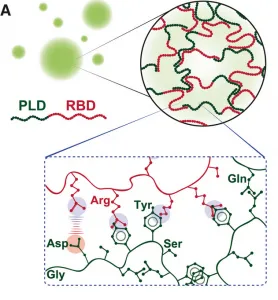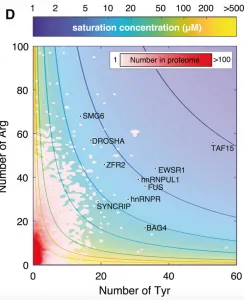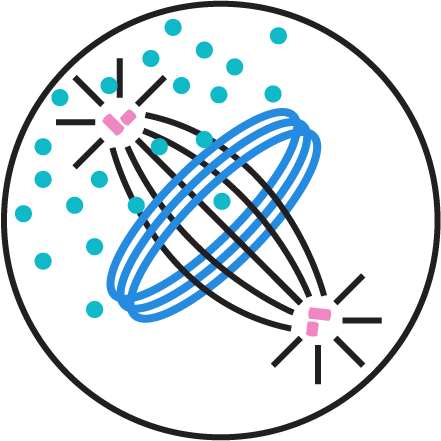Our latest publication is out now in Cell! Congratulations to Jie and all the co-workers.
In this work, Jie Wang and colleagues worked with a family of prion like proteins (FUS family proteins) and suggest rules that define their phase separation behavior. In cells, FUS family proteins can phase separate into liquid like organelles. However, they can form as well aggregates that are linked to neurodegenerative diseases like ALS. Understanding and predicting their phase behavior will lead to a better understanding of their cellular functions.
For a scientific summary of his work and the original publication see below. Click here for a more general summary.

Fig. Hierarchical organization that gives rise to formation of condensates depicted here as spherical droplets
- Phase separation of FUS requires both the N-terminal PLD and the C-terminal RBD
- Tyrosine and arginine govern the saturation concentration of phase separation
- Glycine maintains liquidity, whereas glutamine and serine promote hardening
- An associative polymer model predicts the phase behavior of FUS family proteins

Fig. The number of arginines and tyrosines determine the phase behavior of FUS family proteins
Summary
Proteins such as FUS phase separate to form liquid-like condensates that can harden into less dynamic structures. However, how these properties emerge from the collective interactions of many amino acids remains largely unknown. Here, we use extensive mutagenesis to identify a sequence-encoded molecular grammar underlying the driving forces of phase separation of proteins in the FUS family and test aspects of this grammar in cells. Phase separation is primarily governed by multivalent interactions among tyrosine residues from prion-like domains and arginine residues from RNA-binding domains, which are modulated by negatively charged residues. Glycine residues enhance the fluidity, whereas glutamine and serine residues promote hardening. We develop a model to show that the measured saturation concentrations of phase separation are inversely proportional to the product of the numbers of arginine and tyrosine residues. These results suggest it is possible to predict phase-separation properties based on amino acid sequences.
Original Publication
J. Wang, J.M. Choi, A.S. Holehouse, X. Zhang, M. Jahnel, R. Lemaitre, S. Maharana, A. Pozniakovsky, D. Drechsel, I. Poser, R.V. Pappu, S. Alberti, A.A. Hyman: A molecular grammar underlying the driving forces for phase separation of prion-like RNA binding proteins. Cell, In Press (2018)
